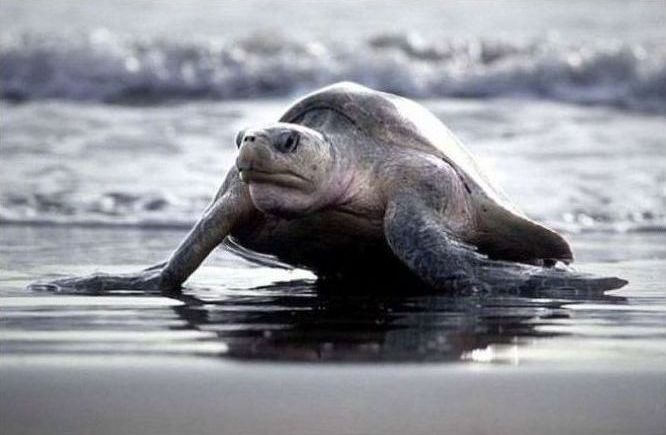|
|
Arribadas, Pacific Olive Ridley Sea Turtles Synchronised Nesting
|
Olive Ridley sea turtles migrate in huge numbers from the beginning of November, every year, for mating and nesting along the coast of Orissa. Gahirmatha coast has the annual nesting figure between one hundred to five hundred thousand, each year. there has been decline in the population of these turtles in the recent past due to mass mortality. Olive Ridley sea turtle has found place in Schedule - I of Indian Wildlife (Protection) Act, 1972 (amended 1991). All the species of sea turtles in the coastal water of Orissa are listed as "endangered" as per IUCN Red Data Book. The sea turtles are protected under the 'Migratory Species Convention' and CITES (Convention of International Trade on Wildlife Flora and Fauna). India is a signatory nation to all these conventions. The 'Homing' characteristics of the Ridley sea turtles make them more prone to mass casualty. The voyage to the natal nesting beaches is the dooming factor for the sea turtles. Since Gahirmatha coast serves as the natal nesting beach for millions of turtles, it has immense importance on turtle conservation.
Olive ridleys generally begin to aggregate near nesting beaches about two months before nesting season, although this may vary throughout its range. In the eastern Pacific, nesting occurs throughout the year, with peak nesting events (arribadas) occurring between September and December. Nesting beaches can be characterized as relatively flat, midbeach zone, and free of debris. Beach fidelity is common, but not absolute. Nesting events are usually nocturnal, but diurnal nesting has been reported, especially during large arribadas. Exact age of sexual maturity is unknown, but this can be somewhat inferred from data on minimum breeding size. For example, the average carapace length of nesting females (n = 251) at Playa Nancite, Costa Rica was determined to be 63.3 cm, with the smallest recorded at 54.0 cm. Females can lay up to three clutches per season, but most will only lay one or two clutches. The female will remain near shore for the internesting period, which is about one month. Mean clutch size varies throughout its range and decreases with each nesting attempt.
A mean clutch size of 116 (30–168 eggs) was observed in Surinam, while nesting females from the eastern Pacific were found to have an average of 105 (74–126 eggs). The incubation period is usually between 45 and 51 days under natural conditions, but may extend to 70 days in poor weather conditions. Eggs incubated at temperatures of 31 to 32°C will produce only females; eggs incubated at 28°C or less will produce solely males; and incubation temperatures of 29 to 30°C will produce a mixed sex clutch. Hatching success can vary by beach and year, due to changing environmental conditions and rates of nest predation.
|
|









